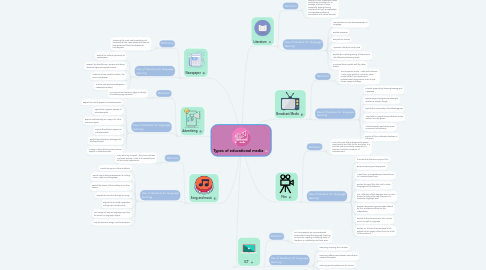
1. Newspaper
1.1. Definition
1.1.1. These are the most easily available and accessible of the news media and they are less ephemeral than their broadcast counterparts.
1.2. Use of literature for language learning
1.2.1. Exploit the cultural specificity of newspapers
1.2.2. Respect the headline as a unique and dense discourse type and exploit as such.
1.2.3. Make use of the parallel medium, the online newspaper.
1.2.4. Practise and exploit strategies for newspaper-reading
2. Advertising
2.1. Definition
2.1.1. It is a prominent discourse type in virtually all contemporary societies.
2.2. Use of literature for language learning
2.2.1. Exploit the inbuilt appeal of advertisements.
2.2.2. Exploit the linguistic density of advertisements.
2.2.3. Exploit intertextuality as a ‘way into’ other discourse types.
2.2.4. Exploit the affective appeal of advertisements
2.2.5. Exploit the advertisers’ strategies for eliciting interest
2.2.6. Analyze cultural behaviors and values implicit in advertisements.
3. Song and music
3.1. Definition
3.1.1. They are truly universal - they cross cultures and even species. Music is an essential part of the human experience.
3.2. Use of literature for language learning
3.2.1. Exploit songs as cultural artefacts.
3.2.2. Exploit the innate predisposition for linking music, rhythm and language.
3.2.3. Exploit the power of the auditory over other senses.
3.2.4. Exploit the emotive strength of songs.
3.2.5. Exploit the mutually supportive melody-lyrics relationship.
3.2.6. Use songs not only as language input but as stimuli for language output.
3.2.7. Use the learners’ songs, not the teacher’s.
4. ICT
4.1. Definiton
4.1.1. ICT has provoked an unprecedented excitement among the language teaching community, inspiring a daunting body of literature in a relatively short time span.
4.2. Use of literature for language learning
4.2.1. Deducing meaning from context
4.2.2. Exploring differences between international varieties of English
4.2.3. Inferring gender preferences for a word
4.2.4. Checking grammar rules
5. Literature
5.1. Definition
5.1.1. Writings that are valued for their beauty of form, especially novels and poetry and plays etc. or writings in prose or verse; especially: writings having excellence of form or expression and expressing ideas of permanent or universal interest.
5.2. Use of literature for language learning
5.2.1. Use literature to stimulate awareness of language
5.2.2. Exploit response
5.2.3. Respect the learner
5.2.4. Approach literature via the task
5.2.5. Exploit the ‘natural grading’ of literature to suit different proficiency levels
5.2.6. Combine literary works with the other media
6. Broadcast Media
6.1. Definition
6.1.1. The broadcast media - radio and television - have many genres in common; news, current affairs, arts reviews and entertainment programmes such as quiz shows, soaps and plays.
6.2. Use of literature for language learning
6.2.1. Counter passivity by listening/viewing with a purpose
6.2.2. Exploit original programme editing to determine excerpt length
6.2.3. Exploit the universality of broadcast genres
6.2.4. View/listen in ways that are authentic to the medium and its genres
6.2.5. (With television) exploit the visual component of television
6.2.6. Exploit all the multimedia features of television
7. Film
7.1. Definition
7.1.1. Film is the one that is designed to appeal most directly and fully to our emotions. It is also the one most clearly entrenched in learners’ minds as a medium of entertainment.
7.2. Use of literature for language learning
7.2.1. Prioritise the affective impact of film.
7.2.2. Balance learning and enjoyment.
7.2.3. Adjust from a comprehension-based focus to a content-based one.
7.2.4. Exploit the input (the film) not to teach language but to release it.
7.2.5. The ‘difficulty’ of the dialogue alone is not a barrier to using a film with learners of a particular language level.
7.2.6. Exploit comparison opportunities offered by film remakes and book-to-film adaptations.
7.2.7. Exploit all the elements of a film, visuals, music, as well as language
7.2.8. Exploit TC films for their portrayal of all aspects of the target culture from the trivial to the profound.

